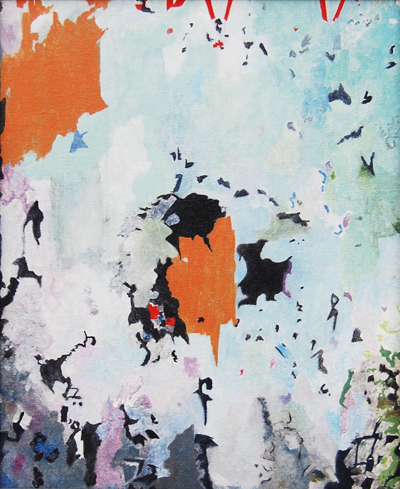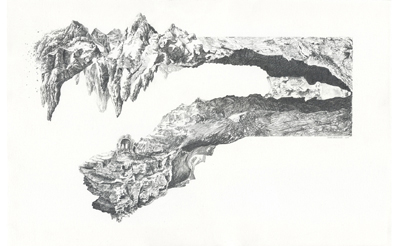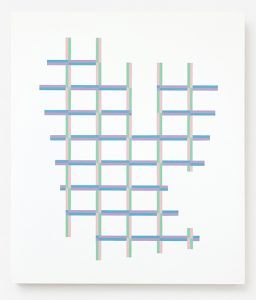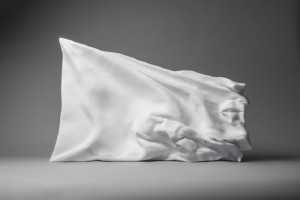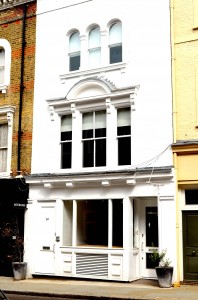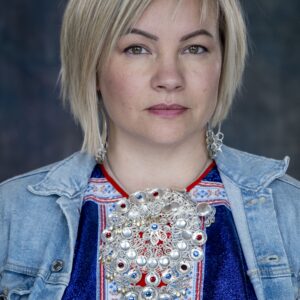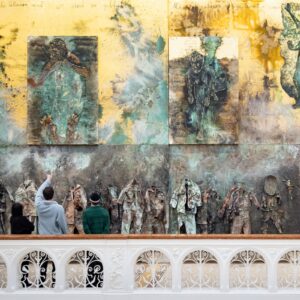Can you think of a better way to spend a sunny afternoon than tucked away on a tranquil, yet lush garden patio in Camden Town with two equally unique and visually striking artists? Painters, collagers, builders and constructors of imaginative, yet relevant atmospheres, Fred Sorrell and Merlin Ramos were gracious enough to take the time to chat with me, VC, about their upcoming group show, ‘SHOT’ opening at Kristin Hjellegjerde (ArtEco) Gallery on the 1st of August.
After spending five minutes with these two, it was easy to observe that their chemistry with one another is not only organic, but is also extremely charming and inviting. More like a delightful afternoon conversation, rather than an uptight interview, it was nice to kick back and gain a precise understanding of what these gentlemen are striving to bring to the contemporary, artistic table.
Having met at Falmouth College of Art in their ripe early 20’s, Sorrell and Ramos have been connected at the artistic hip ever since. And judging from the looks of things, it seems as though they couldn’t be more confident in how they would like the rest of their careers to progress forward. Although it was predominately Sorrell and Ramos who conjured the constructs of the show’s theme and title, this enticing exhibit could not exist without three other similarly talented and internationally acclaimed artists: Haroun Haward, Ingri Haraldsen, and Louise Thomas. Collectively, their work assists in shaping a thoughtful and dynamic conversation. Like 5 points completing a shining star, each artist addresses their own intelligent, yet somewhat playful perceptions concerning time, what it means to be an ‘urban’ artist living amongst an ‘urban’ landscape, and how these circumstances play a major role throughout the processes of their production.
‘Shot’ is an extremely intriguing title, what triggered this particular heading?
Fred: Originally, the word ‘Shot’ came from this whimsical idea of ‘shot through the prism of our imagination’.
Merlin: We could even say that the original concept stems from the idea of the Greenhouse. Not like a greenhouse ‘save the world’ in a literal sense, but in the sense that this ‘greenhouse’ serves as an analogy for what we do as artists. We are constantly looking in while looking out, with hopes to close in on a deeper meaning.
Fred: Yes and this ‘prism’ if you will, is a complex lens which Merlin and I attempt, and have always attempted, to peer through within the production of our work. So, the title alludes to this kind of fantastical, playful, and alternate perceptions that we are offered in life- if we look close enough. Where we are seeking to capture a ‘shot’ in time and to deeply explore the disconnect between humans and the landscape, leading the medium of painting away from traditional subjects, thus transforming the way we think and interact within the space in which we live and communicate on a global scale. Much of the foundation for the show is embedded in this idea of how the role of the painter has dramatically shifted from venturing out and painting in the fields like in the early 20th and 21st century to now dealing with the circumstances of painting admist a contemporary urban environment. Quite frankly, our work is just a major response to these societal transformations.
What does it mean to be ‘Urban’ exactly?
Fred: Exactly, what does this mean? We are engaging with this question, while remaining considerate and in tune with the juxtaposition of people against surfaces, all of which we attempt to bring to fruition in an almost abstract way.
So the two of you have been exploring these intricate realms for some time now.How did you know that it was time to take this conversation to the next level with a group show, and better yet, how were you sure which artists would fit best?
Fred: We (the five of us, including myself) have always been aware of how similarly each of our work tends to treat the above mentioned themes which we wish to fully extrapolate. Even though we might live in various cities or have alternate backgrounds from one another, we all share a similar aesthetic connection. Stylistically our works might ‘appear’ different, but we somehow fit on the same page, or at least in the same chapter. We are all attempting to explore parallel concepts which intrinsically both effect and characterize the final executions inherent in our work. With this in mind, Merlin and I took it upon ourselves to approach Kristen Hjellegjerde, the gallery founder and Curator of Art Eco, explaining our concept and aims. And she couldn’t have been more supportive.
Merlin: Conjointly, our work speaks inquisitively to one another, where these differences are both welcomed, and necessary in delivering the best complimentary dialogue. We all have relatable stories to tell, we just do so in our own way, and our uniqueness and individuality is only strengthened when our works are juxtaposed amongst one another, allowing for a more comprehensive and corresponding narrative to become provoked and elaborately questioned.
Merlin, what is the narrative you wish to express?
Merlin: In my most recent work, I am attempting to playfully render paint in order to express what it means to be a painter. I am deeply affected by my surroundings both environmental and man made. Inspiring brushstrokes which consist of combinations of clean, geometric forms with organic swathes and slashes of paint, and in some places, the works can tend, I guess you could say, to have an almost Cubist element to them. The colours in my work are a reference to my travels and admiration of artwork found in Japanese artists such as Hiroshige and Hokusai. Using cascading and fallen elements of our world in the work appeals to me, making a reworked patchwork of our world, or some world, while simultaneously weaving together a contrasting variety of interests I have. So I am investigating the process of making in various different ways, putting together constructions that are talking about painting but also about the way they are being made. The process is purposefully shown in the pieces so that you can get an understanding. However, I don’t want them to be completely finished, prissy or over polished. And in the same respect, I do not wish for them to be works in progress, but rather a working model so people can visualize for themselves how the compositions become organically constructed. I want people to read a bit more into it, and raise questions of their own.
Fallen Geometry, Merlin Ramos 2013 (Acrylic and oil on canvas)
Fred: Yes. I think this is a theme which weighs heavy within many of our works.
Fred, how would you describe your narrative or process?
Fred: I use torn posters from underground tube platforms as inspiration for my ‘collage like paintings’. With the torn poster, sometimes, or most of the time, it is quite accidental and many of the posters I choose to incorporate are only going to be on display to the public for a short time- as living in a fast paced city like London usually ensues. But these posters are valuable, as they represent shared memories of time. Memories that all walks of life experience together even though they might hardly think twice about this and quickly wisk past them towards their daily obligations on a diurnal basis.
Have you always been interested in this kind of representation?
Fred: In the past my work dealt with figures, but I have spent alot of time relearning and re-harnessing foundational skills which has led me to take these practices to another level. I would say that these ‘new’ practices intertwined with my fascination of the contrast between various materials and natural decay could accurately sum up my work. There are times when I see a big blank advertising or construction board that commands such an entrancing presence. They can contain such a unique, almost totemic quality that I feel immediately inclined to recreate the composition while adding my own story to it.
Green Park, Fred Sorrell, 2013
Merlin: your new work is predicated on a much stronger and deeper notion of form and balance. So meticulously rendered, yet it still obtains a freedom all on it’s own.
Fred: Deciding to stray away from figure painting was kind of a huge call for me and a massive stylistic decision. But even though these creative developments have occurred, on both my end and yours, we have still maintained these gestural free flowing strokes, while still executing a concentrated effort and clean presentation.
Merlin: Clean, yet free. We have almost contrived this type of technique from living in a city like London where one minute you have a glistening and commanding architectural structure like the Shard, and then just 4 blocks further, the environment becomes a bit rusty and raw, which is just as an important component to the construction of a big city as its glossy and seemingly artificial counterparts. Every city has a rich history. As Fred says, We should take the time to ‘Peel back the layers’.There is always so much random constructing and deconstructing both underground and above. We are just trying our best to capture what it all means, or more importantly, how it aids in defining the state of our current existence.
So, how do Louise Thomas, Ingri Haraldsen and Haroun Haward fit into the mix?
Fred: Louise Thomas’s work obtains a built up, collaging effect. Her work also deeply explores the meeting point of landscape, memory, and architecture. While simultaneously attempting to capture fleeting moments of experience. She questions the architectural structures she finds within her political and historical context and weaves them into her own subjective perspective causing for an alluring and captivating scene. They convey the cosmopolitan dream of escape mixed with the uncanny as they critique the mechanical structures of contemporary tourism, leisure and entertainment industries.
Merlin: Louise and I also met at Falmouth and having known each other for some time now are inevitably very much inspired by each other. Our styles used to be much more similar, but have now become quite different as we both have grown and evolved. It is fascinating how Louise’s studio is in Berlin and mine is here in London (Tottenham) and we obviously hold the same ideals and wish to project the same messages, but have entirely different routes to get there. This is what is so enchanting about this group exhibition.
After the Orchestra, Louise Thomas, 2013 (oil on canvas)
And Ingri?
Merlin: Although she works with pencils and her compositions are black and white or grey, they tend to be, if you will, strikingly different from mine. However, the idea of construction of cities through the layering up effect- or collaging is just the same. She builds things together through pencil and I do through painting- we are both creating something that is almost pseudo 3d. It is not meant to be a sculpture but it is meant to have elements which cascade down the canvas.
Time at a Stop, Ingri Haraldsen, 2013
Fred: It was actually Merlin’s idea to bring Ingri into the show as he thought she would be a great contrast to the rest of our works.
Merlin: Ingri has a really delicate way of expressing work on paper extremely well. She also has an eloquent way of describing, in a slightly more mythological way, what we are trying to say with this idea of ‘Shot’. Where mine would not be so mythological, but rather more literal in my interpretations of dealing with architecture and landscape.
Ostensibly, Haroun Haward has known Sorrell for years through mutual friends. And just to kick things up- or back- he has planted a bit of an allusive spin into the frame of the show. Haward has decided to feature only one massive diptych comprised of oil on wooden panels. His contribution is part of an ongoing series he has been working on this year, part of an investigation into museum culture and archiving. For him, Ancient mythology speaks both to his love of storytelling as well as his interest in museum cultures and engaging with shared histories, exploring art history, the history of man and how we reflect on our past by connecting with antiquity. His work speaks to the interest of this intellectual duality. He feels these narratives give us insights into the worlds of the ancients, but also perpetuate the mysteries of what has gone before. Expanding on this duality and tension, both panels of his diptych feature paintings of objects on plinths, which in turn are then filled in with patterns, motifs and designs from various sources, darkening silhouettes with tinted layers of linseed oil, trapping them, encasing them into what almost feels like a painterly vitrine.
Just to give you somewhat of an idea, although it will not be in the show -this is one of Haward’s past works
Merlin: Haroun’s work is a cultural history which has kind of stopped in time where as mine is stopping the construction of cities and looking at building sites- where Fred is putting together constructions of shapes and colors where some of them almost cascade into one another dripping in and out of perceptions of time.
How many works do each of you plan to offer?
Fred: I have eight (including the one featured above)
Merlin: I would like to hang six (including the one featured above) But, I am not quite sure which 6 it will be. I am predicting it will come down to much trial and error and ensuring that all of the spacial and aesthetic circumstances coincide with the rest of the works which will be featured.
How are you planning to hang all of the works before the show opens?
Fred: We (all five of us) have decided to hang the works around Haroun’s diptych in order to coherently solidify and thread together the narrative we are all attempting to tell.(Except Ingri Haraldsen, as she is pregant, based in Norway and is unable to be present for both the hanging and the opening- but has been in thorough communication with Hjellegjerde and her other 4 start points). We all thought it was important to be there hanging our works together, bouncing ideas off one another and playing with the operative and transitional space ArtEco has to offer. Like the collaging technique which our work collectively exemplifies, we are confident the presentation embedded within the curation process, will balance in all the right ways. Where the voices of the five points will weave together providing for a perfectly juxtaposed yet harmonious, colourful journey for our viewers.
How involved has Kristen Hjellegjerde been in both the curatorial and development process of the exhibition?
Fred: Kristen has been extremely involved and is incredibly hands on. She adheres to an inspiring philosohoy on how to most effectively treat and conversate with artists. Her genuine approach to us, both one on one and collectively, is entirely honorable.
Merlin: I agree. She really understands the true meaning and value which treating others with the utmost respect can facilitate.
So what is next after this show?
Fred: We would like to potentially do a ‘Shot 2’ of some sort. Honestly, we are really searching for ways to continue to keep working and to expand this ever developing concept. We (Merlin and I) havn’t painted together in a while and I think it is good in some ways because we have both grown in a direction which seems to be really solid. We strongly feel that our works (all five) help to shed both a new asethtically and philosophically pleasing light on what it means to ‘shoot’ through relativities of time and our circumstantial surroundings, providing for a alluring group show which only holds more potential to shine deeper and further.
Fun fact: Not only are these two contemporary debonaires well versed in the art of painting, they also have somewhat unusual interests which simultaneously feed into their creative practice. Fred is becoming more well known around the London city blocks as a nerve calming masseur who is notorious for, like a modern day alchemist, conjuring his own scented oils in order to treat symptoms for his tightly wound up patients. Effectively curing anything from a sore shoulder to a broken heart- or both! And Mr. Merlin just so happens to be an extremley quaified Sommelier and innovative mixologist.
So what will the drinks of choice be for the opening night?
The wine shall be a bit of a surprise, as I will know closer to the date. As for the cocktail- I am thinking a twist on a classic thirst quenching cordial, one composed of: gin, herring dutch cherry liquor and Campari with a bit of lemon.
Sounds deliciously delightful for a hot summer afternoon, do you think we could sample some now?
Fred and Merlin Chuckle…
Merlin: No unfortunately, like the final unfolding of the exhibition, you will just have to show up to the opening!
So there you have it! Spoken from the two conjurer’s of ‘Shot’ themselves. Filled with layers of suprises, thought provoking works and insightful conversation (both methaphorically and literally) you should be sure to catch this private view as it could quite possibly make for one of the hottest openings of the summer!
For more information on Art Eco Gallery and other current or past shows go: HERE
To hear more from Fred Sorrell on his latest work go: HERE

